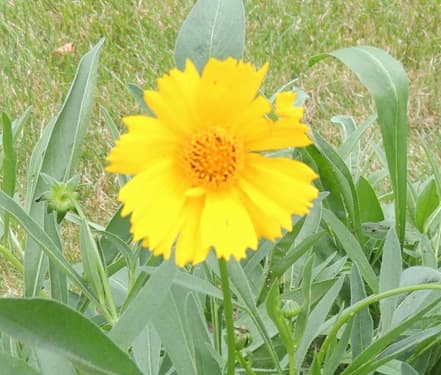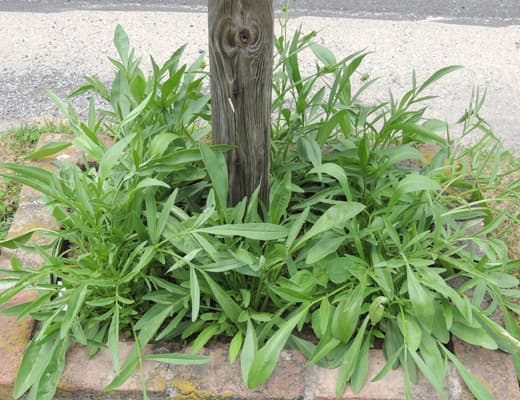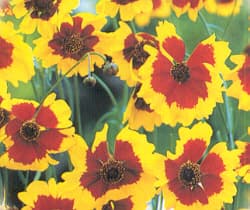How to Grow Coreopsis Flowers

About Growing Perennial Coreopsis in Your Home Flower Garden
Perennial Coreopsis flowers are members of the sunflower family. They look a lot like a daisy. It is sometimes called “Tickseed” or “Calliopsis”. The 75 to 80 species of this plant come in a wide variety of bright and cheerful colors. Yellow is by far the most popular in home gardens. The flowers bloom on sturdy stalks that grow from 1 1/2′ to 4′ tall. While most varieties are perennials, there are a few annual varieties. This wildflower is native to prairies and dry plains. You will find that growing Coreopsis is simple and easy. They are a low-maintenance plant.
Coreopsis gets its name from the Greek word for “bug”. It was given this name because its dried, flat fruit resembles a bug. Another meaning of the word is “Always Joyful”.
The Coreopsis flower attracts birds and butterflies. Songbirds like the flower pods that are filled with seeds. Coreopsis makes excellent cut flowers, too. The strong stems do not require staking.
Grow Coreopsis in a wildflower setting, or towards the back of your flower garden. Try growing shorter varieties in flowerpots on your patio or deck.
Coreopsis Plant Specifications
Flower colors: Colors include bronze, burgundy, maroon, orange, pink, red, yellow, and white.
Flowers Blooms: spring, summer, or fall, depending upon variety. See seed packets.
Plant Height: 1 1/2 to 4 feet depending upon variety.
Light Requirements: Full sunlight.
Ideal Soil pH: 5.5 – 6.5.
Hardiness Zone: 2 – 11.
Toxicity: Non-toxic.
Deer Resistant? Yes. The flavor, texture, and smell keep deer away.
Native To: All 75 – 80 species of Coreopsis are native to North, South, and Central America.
Plant Type: Perennial.
Botanical Name: Coreopsis Grandiflora
Other Names: Tickseed, Calliopsis
Popular Varieties: Lance Leaved, Sunray
Are Coreopsis Edible?
YES!!
Use the plant as an herbal tea. And, you can dry the plant to use it as a substitute for coffee.
Native Americans used it as a dye for fabrics.
Medicinal Uses for Coreopsis Plants
Coreopsis has a variety of medicinal applications. Some of them are: antidiabetic, anti-cardiovascular diseases, antioxidant, and anti-inflammatory properties

Plant Light Requirements
Grow coreopsis plants in full sunlight. For the healthiest plants and best blooms, select a location for them that receives at least six to eight hours of direct sun.
Grown in full sun, the flower stems are strong and do not require staking. However, with too little light, the stems may grow weaker and lanky. And, without sufficient light, there will be fewer and smaller flowers.
Coreopsis Plant Propagation
Coreopsis is grown from seed.
Sow Coreopsis seeds directly into the garden early in the season. Cover the seeds lightly with coarse or sandy soil. Keep the soil moist until they germinate.
The plants can also be started indoors. Sow Coreopsis seed 4-6 weeks before the last frost in your area.
The final spacing for the plants is about 12″ apart. Plants will bloom approximately 60 days after planting.
Note: For varieties with a long germination period, we recommend a heated germination mat.
Days to Germination: 7 – 30, depending upon the variety.

How to Grow Coreopsis Flower Plants
Growing Coreopsis is easy. Once this low-maintenance plant is established, it will thrive for years.
Coreopsis plants prefer a warm climate and are full to partial sun. Being native to prairies and dry plains, it prefers a dry environment but will tolerate occasional wet weather.
The plants grow best in average soil. Actually, they do not do well in rich soil. So, there is no need to amend the soil with compost.
Add general-purpose fertilizer at planting time and again before the flowers bloom.
For best plant performance, keep the soil evenly moist during the growing season. During dry periods, it will survive with little water. But, it’s absolutely okay to pamper it with an occasional drink of water during an extended drought.
Do you want to collect coreopsis seeds for planting next year? Near the end of the season, allow a few of the flowers to die off and form seed pods. Then, let the pods mature and dry. If birds are going after the seed pods, cover the plant lightly with pest netting. Collect the seed pods and remove the seeds. Then, store the seeds in a cool dry place until next spring.
Gardening Tip: Package up a few seeds for your gardening friends!
Pruning Coreopsis Plants
As previously mentioned, Coreopsis plants are very low maintenance. However, for a tidy appearance immediately remove any weak or dead leaves and stems. If new flowers are tapering off, give the plant a good trim. In a few weeks, it will reward you with a profusion blooms.
Deadheading spent blooms encourages the plant to produce new flower buds continuously over the season.
Overwintering Perennial Coreopsis Plants
These durable plants grow well in almost all hardiness zones. In the coldest areas of the country, there are a couple of steps to take that will ensure they survive the winter and are ready to thrive again in the spring.
After frost or freeze has killed off the plant for the season, cut the plant back to at or near the ground. Then, apply a thick layer of mulch over them This protects the roots from a hard and deep ground freeze.
Insects and Plant Disease
Perennial Coreopsis flowers seldom have insect or disease problems.
If insect or disease problems occur, treat the plants at the first sign of a problem with organic or chemical insect repellents and fungicides.
Also see: Plant Problems – causes and cures.
Related Articles
People who read this article will also like:
How to Grow Coreopsis Plants – by Garden Hobbies
Please support our site. Shop for:
- rmmatthews100@hotmail.com
- 585-721-6528
- Rochester, NY
©1999-2024 GardenersNet.Com, All Rights Reserved

